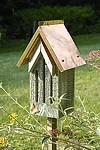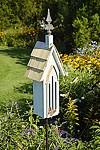 Butterflies are among the most beautiful insects on earth---and
one of the few insects we desire to see in our flower gardens! Their
colorful wings add a decorator's touch to our gardens as they flutter from
flower to flower in search for nectar. Most gardeners wish they could
attract more butterflies to their property.
Butterflies are among the most beautiful insects on earth---and
one of the few insects we desire to see in our flower gardens! Their
colorful wings add a decorator's touch to our gardens as they flutter from
flower to flower in search for nectar. Most gardeners wish they could
attract more butterflies to their property.
Attracting butterflies to your garden involves
essentially two things: (1) planting the right flowers in the right place,
and (2) refraining from the use of chemical insecticides. To attract more
species of butterflies, you could add to the butterfly garden a mud
puddle, a bowl of rotting fruit, and/or mammal manure. With or without
these additional lures, however, many butterflies will be enticed to visit
a garden that provides desirable nectar sources which are not poisoned
with insecticides.
The location of your property plays a role in determining how many
butterfly species might visit your garden for flower nectar. Some species
of butterflies prefer open areas while others elect to reside near wet
meadows or deciduous forests. Thus, a person living in an open rural area,
near a stream or swamp, and adjacent to a deciduous forest will likely
attract more species of butterflies to his or her garden than will a city
dweller.
The best position for a butterfly garden is in full
sun. Butterflies are cold-blooded insects that can only fly well when
their body temperatures are above 70 degrees F. You have probably noticed
that butterfly activity is limited on cool, cloudy days and increased on
warm, sunny days. Without warmth, butterflies are physically unable to
fly. It is advisable to plant the butterfly garden in a
location that is sheltered from the wind. Wind currents make flight
maneuver difficult for butterflies and require the expenditure of extra
energy as they try to feed, mate, and lay eggs. A wind break can be
provided by simply planting evergreens to protect the garden from
prevailing winds.
When deciding on the plants to incorporate into your
butterfly garden, choose a mixture of annuals and perennials. Annuals
bloom all summer but must be replanted every spring (after the last
frost). Perennials bloom year after year from the same roots but their
blooming periods are typically limited to a few weeks or months. To enable the sight of most of the flowers (and
butterflies) in your garden, plant the shortest flowers in front and the
tallest ones in the back. Plant flower species in masses as butterflies
seem to choose those flowers that are most abundant. Being equipped with a
highly sensitive sense of smell, butterflies are able to identify clusters
of nectar flowers from quite a distance.
Across the United States, there seems to be little
consensus on the flower color or flower species that most attracts
butterflies. Some experts claim that butterflies prefer purple, lavender,
and pink flowers. Others proclaim red, yellow, and blue blossoms to be the
color preference of nectar-seeking butterflies. Some butterfly gardeners
insist that Lantana is an excellent butterfly-attracting plant while
others insist that it is not. It is likely the case that different species of
butterflies show a preference for different species of flowers. And since
different species of butterflies inhabit different regions of the U.S.,
different flowers may be utilized for nectar in different
regions.
The selection of flowers offered as nectar
sources also plays a role in what the butterflies choose as nectar
sources. If a garden includes butterfly bushes, Mexican sunflowers, and
purple coneflowers, you will likely find most of the feeding butterflies
on these flowers. If hungry butterflies do not have the option of feeding
on butterfly bushes, Mexican sunflowers, and purple coneflowers though,
they will settle for something less desirable just to get their hunger
satisfied.
Though avid North American butterfly gardeners
may disagree on many aspects of butterfly gardening, they tend to agree
that every butterfly garden should include butterfly bushes
(Buddleia davidii). Throughout the United States, the
flowers of butterfly bush prove to be irresistable to many species of
butterflies. Butterfly bushes grow 4' to 12' high, depending upon the
variety chosen. Blooming mid July through frost, their fragrant flower
spikes may be white, lavender, pink, or purple.
Among the
best perennials for attracting butterflies to the garden for feeding are
butterfly weed (Asclepias tuberosa), swamp milkweed (Asclepias
incarnata), purple coneflower (Echinacea purpurea),
Stoke's aster (Stokesia laevis), tickseed (Coreopsis),
lavender (Lavandula), blanket flower (Gaillardia aristata,
Gaillardia grandiflora)), Joe-Pye weed (Eupatorium purpureum),
and pincushion flower (Scabiosa columbaria). Other perennials
utilized as butterfly nectar sources include black-eyed Susan
(Rudbeckia), dame's rocket (Hesperis matrolalis), hardy
ageratum (Eupatorium coelestinum), heliopsis (Heliopsis
helianthoides), ornamental oregano (Origanum
lacvigatum), pinks (Dianthus), showy stonecrop (Sedum
spectabile), beebalm (Monarda didyma), goldenrod
(Solidago), red valerian (Centranthus), daylily
(Hemerocallis), hyssop (Hyssopus), Phlox, and
Aster.
To ensure the availability of nectar sources
throughout the summer, long-blooming annuals should be planted between the
perennials you choose for planting. Zinnia, tropical milkweed, Mexican
sunflower, cosmos, verbena, lantana, pentas, strawflower, and
heliotrope are good annual choices for the butterfly garden. Experiment
with different flower colors to determine what the butterflies in your
area seem to prefer. Just by planting the right flowers in the right place,
you will likely attract many species of butterflies to your garden. Amidst
these butterflies will probably be Monarchs, Swallowtails, Painted Ladies,
Red Admirals, Fritillaries, Hairstreaks, Coppers, and Crescents.
While flower nectar is the chief
food source for most butterflies, a few butterfly species prefer to feast
on rotting fruit, mud, and/or mammal manure. Red Admirals, Red-spotted
Purples, Commas, and Mourning Cloaks are among those butterflies that
sometimes dine on rotting fruit. Spring Azures, Eastern Tailed Blues,
Sulphurs, and Swallowtails are known to extract nutrients from mud.
Viceroys, Red Admirals, Meadow Fritillaries, and other butterfly species
periodically feast on mammal manure.
Butterflies add beauty to our
world and fascinate people of every age. Entice butterflies to visit your
own back yard by planting the flowers that most appeal to
them!





 Flutterby Butterfly Feeder-12 oz
Flutterby Butterfly Feeder-12 oz
 Heartwood Butterfly Belle Butterfly House
Heartwood Butterfly Belle Butterfly House

 Heartwood Butterfly Bijou House
Heartwood Butterfly Bijou House

 Heartwood Butterfly Chapel
Heartwood Butterfly Chapel

 Heartwood Mademoiselle Butterfly
Heartwood Mademoiselle Butterfly

 Nectar Pot
Nectar Pot

 Woodside Gardens
The Registry of Nature Habitats
Woodside Gardens
The Registry of Nature Habitats 
 1999 -
1999 -
 Butterflies are among the most beautiful insects on earth---and
one of the few insects we desire to see in our flower gardens! Their
colorful wings add a decorator's touch to our gardens as they flutter from
flower to flower in search for nectar. Most gardeners wish they could
attract more butterflies to their property.
Butterflies are among the most beautiful insects on earth---and
one of the few insects we desire to see in our flower gardens! Their
colorful wings add a decorator's touch to our gardens as they flutter from
flower to flower in search for nectar. Most gardeners wish they could
attract more butterflies to their property.